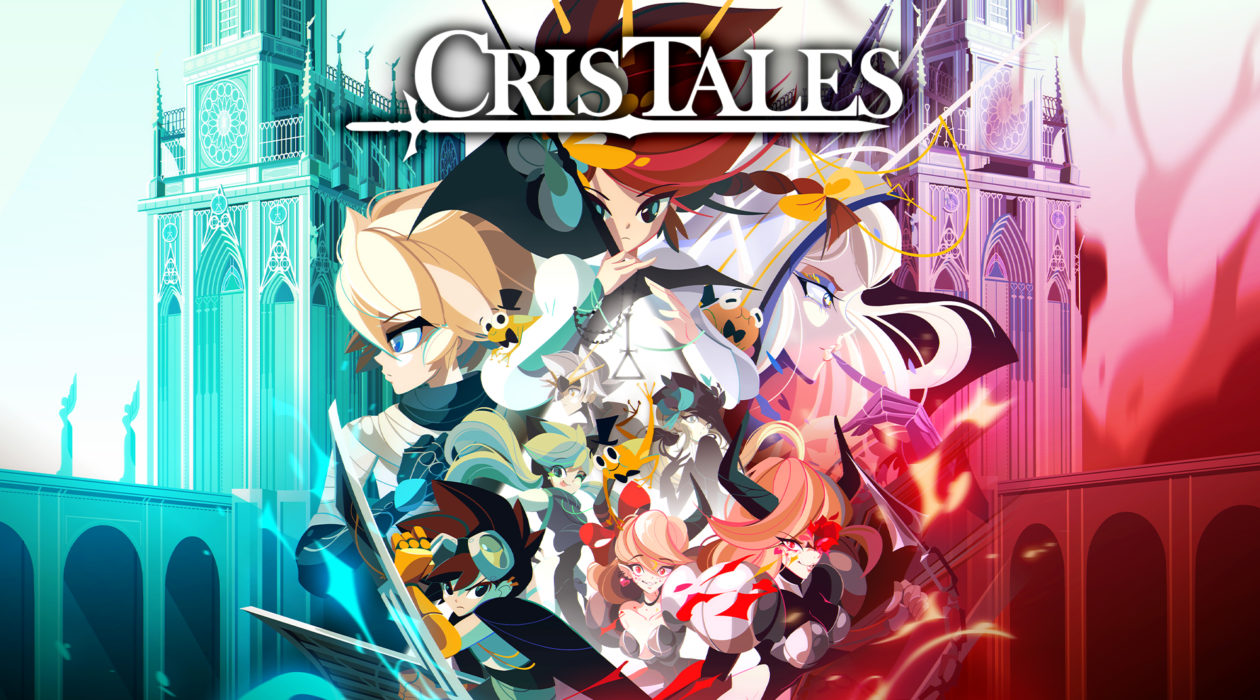It’s not just you. The word Cris Tales, yeah, it sounds uncannily like Crystals. I see it too. We’re clever you and I, we sussed out their little pun. It’s pretty apt, because Cris Tales is obsessed with Crystals, and also with channelling the ethos and aura of the biggest crystal afficionados out there. No, I’m not talking about the wannabe druids who run that wacky crystal shop in town and think a piece of quartz will cure your chakras. I’m talking about Squaresoft, or Square Enix as they are known these days.
Those guys were/are obsessed with crystals – almost every Final Fantasy and its spin-offs has involved crystals in some form. They are the magical focus of the Mana series, and front and centre of the Bravely Default games. They are the magic that runs the JRPG genre, especially in the classic era. So for Cris Tales, a very deliberate attempt to capture the magic of classic JRPGs, it makes no end of sense for it to be a very Squaresoft feeling game. From the turn-based elemental battles, to the party-gathering epic journey, the dark empire to rebel against, and the infatuation with time magic and crystals, everything here evokes nostalgia for those classic adventures, and does it with modern flair and skill.
So it’s going to appeal to fans of JRPGs, but is it as good as your rose-tinted memories of those retro adventures?

With a gleaming *schwing* noise, the Cris Tales logo appears. I got a good feeling. Our story starts with Crisbell, a young orphan girl who lives at an orphanage in a little town. While out picking roses for the Mother Superior who raised her, Crisbell comes across a talking frog named Matias (one party member not human – check) who leads her to the cathedral and an ornate stained-glass window. There Crisbell awakens the time crystal, and her time mage powers. She can see into the past, present and future, all at the same time, and all on screen at once. Matias the frog can jump from one time period to another, but more on that in a moment. With the time sword in hand, she can also cut the very fabric of time and send enemies back and forth in time, affecting how battles play out.
There’s little time to waste as the town is under attack. Crisbell quickly enlists the help of Wilhelm, an established time mage trapped in the body of a young boy (who everyone seems to treat as a child), and Cristopher, a young man who is out to stop the nefarious empire who killed his elder brother in the war, and sends the small force of goblins packing.
But this is just the beginning of a journey that will take her across the world to seek out the six cathedrals in six different cities and enhance her time magic abilities enough to take on the evil Time Empress. As you venture into the world, every town in Cris Tales is its own story hub, often rife with its own political issues, characters and motivations. It up to you to get involved and resolve them. Take the first major town as an example, because I don’t want to spoil too much story. St Clarity is a walled city that functions like a dam, bearing down on Floodlight, a slum that is now periodically flooded due to the industrialisation of their chief export, magical rubies. Cristopher’s father is an activist in the lower city, and his mother is in a new relationship with the tyrant who has ordered the industrialisation. Its into this highly charged atmosphere that you invade, like a wrench thrown in the gears. This kind of intricate and sensitive political detail is available in every locale, and sets Cris Tales above in its world-building.
With their combined powers Crisbell and Matias can uncover items in the past that are thought lost, listen to secrets from long ago, and warn of the dangers in the future if things aren’t changed. She becomes the catalyst for change in every town and city she visits. In most, all your meddling will eventually result in a pivotal decision; do you elect one person, or another? Do you change the city in one way or another? The choices are binary, but with grey in the outcome. You get to see what your choice provoked in the future state, but beyond that I can’t think of any choice I made that affected the story beyond exiting that particular city.
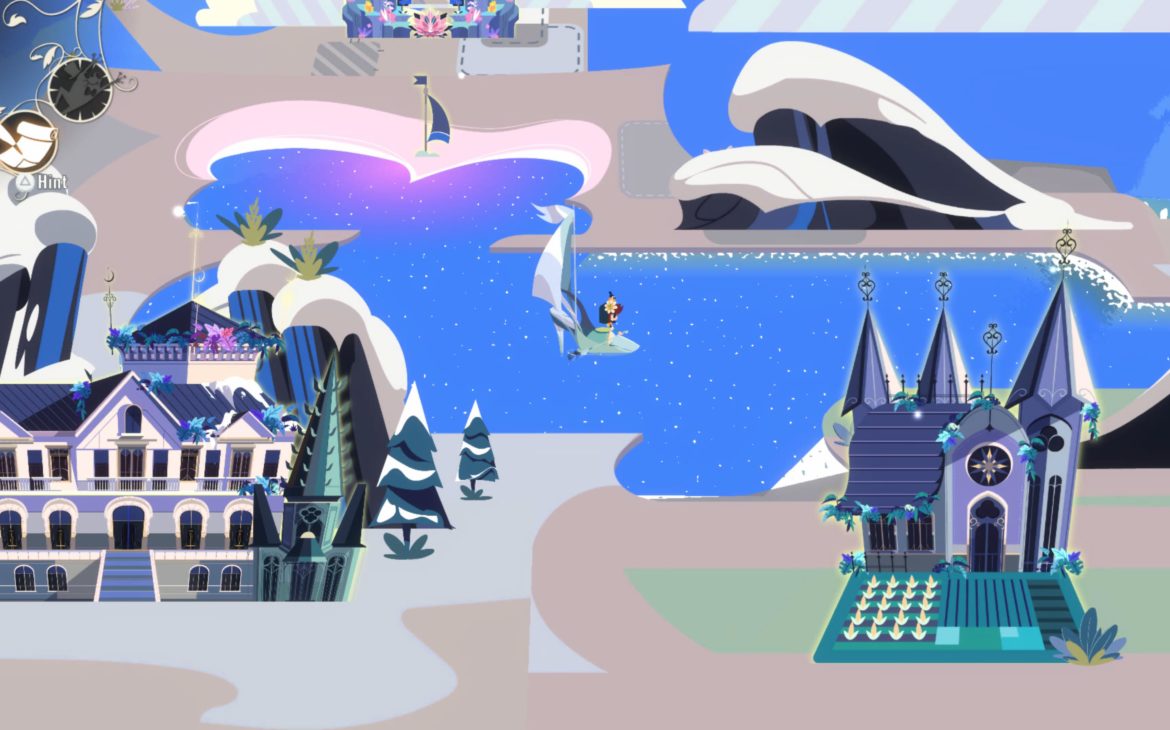
Cris Tales has lots of nice dialogue and well delivered performances in a fully voiced story. However for a game setting itself up to be a grand epic like classic JRPGs its actually pretty thin on the ground. There’s the six locations and a collection of dungeons and such around each, but I was more than halfway through the story in barely ten hours, so do be aware that this is not a fifty-hour epic. It’s an indie game with a lush and classic JRPG style, but maybe not with the content extent chops that spring to mind. It is priced accordingly, at about half the cost of your average AAA title. I just want to manage expectations.
After a few instances where you send Matias into the past or future to retrieve something, the mechanic kind of reveals itself for what it is – a gimmick. Essentially you must be standing in the same place anyway, and then just send Matias to get an item or listen to someone. You can’t really explore because Matias can only crawl or hop so far away from Crisbell, and he moves so damn slowly anyway. It’s just an extra step to pick up an item. I’m glad to see the plot was written around needing to use it in each city, but the actual mechanic is lacking in any real gameplay.
The Time Empress (which just makes me think of FF8 and Ultimecia) was a villain I found merely infuriating rather than evil or compelling. She swoons and smarms about her dialogue sections like Jessie from Team Rocket, sort of laughable really, so when I did beat her, I thought it more mercy than triumph. Sorry, a mercy to me, not her.
Cris Tales has a lot of the ingredients of the classic JRPG and some drop-dead gorgeous artwork, but I think the story was tackled more like a visual novel with places to visit, and individual questline stories to solve. It has a nice cast of very likable characters, but beyond each one’s individual back story quirk, which they all had, they didn’t really get fleshed out that far. For a story that sets itself up like this to wrap up in around 20 hours, was also a little disappointing. If you enjoy the battles, which we will talk about in a moment, then you’re just getting into your stride at the point the story ends.
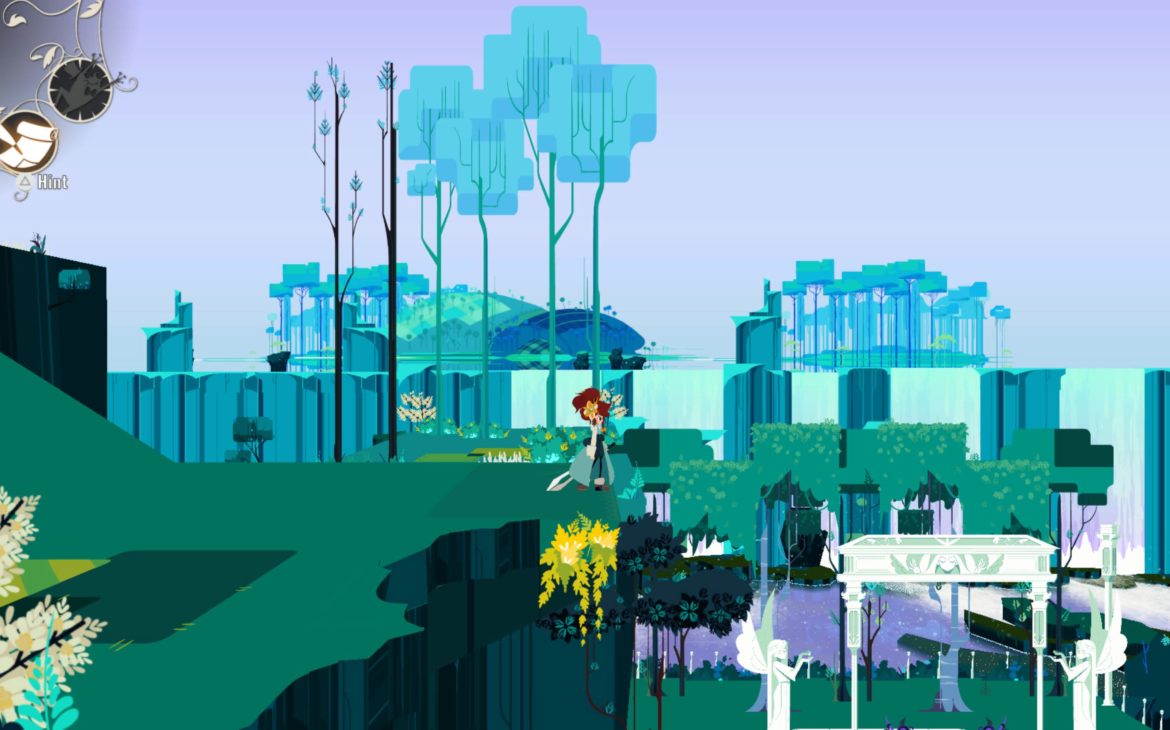
Like a classic RPG, in Cris Tales you need to contend with random encounters. It’s something I thought we had left firmly in the past, and with good reason. There’s nothing like the thrill/pain of trying to get to the end of an area without provoking yet another random encounter. But with new technology came the ability to have enemies on screen, and these days you barely need another battle screen. So it’s a stylistic choice, and one that certainly evokes those memories from the nineties and early noughties, but I can’t really say it’s a good thing. I think I would have preferred enemies on screen, to avoid, especially considering the lack of healing abilities early on and falling foul of a single very high-powered battle I wasn’t expecting, sending me back half an hour of levelling.
Cris Tales combat is turn-based and to begin with manages to use the time crystal and time sword ideas to unique effect. I promise you this is a battle system you’ve never quite seen before, and to be able to rif something new on turn-based battle systems in this day and age is commendable. You are generally surrounded in almost any battle, but here, instead of receiving increased damage from back attacks for example, you are suddenly able to use both sides of your time crystal powers; either propelling enemies on the right into the future, or sending those on the left into the past.
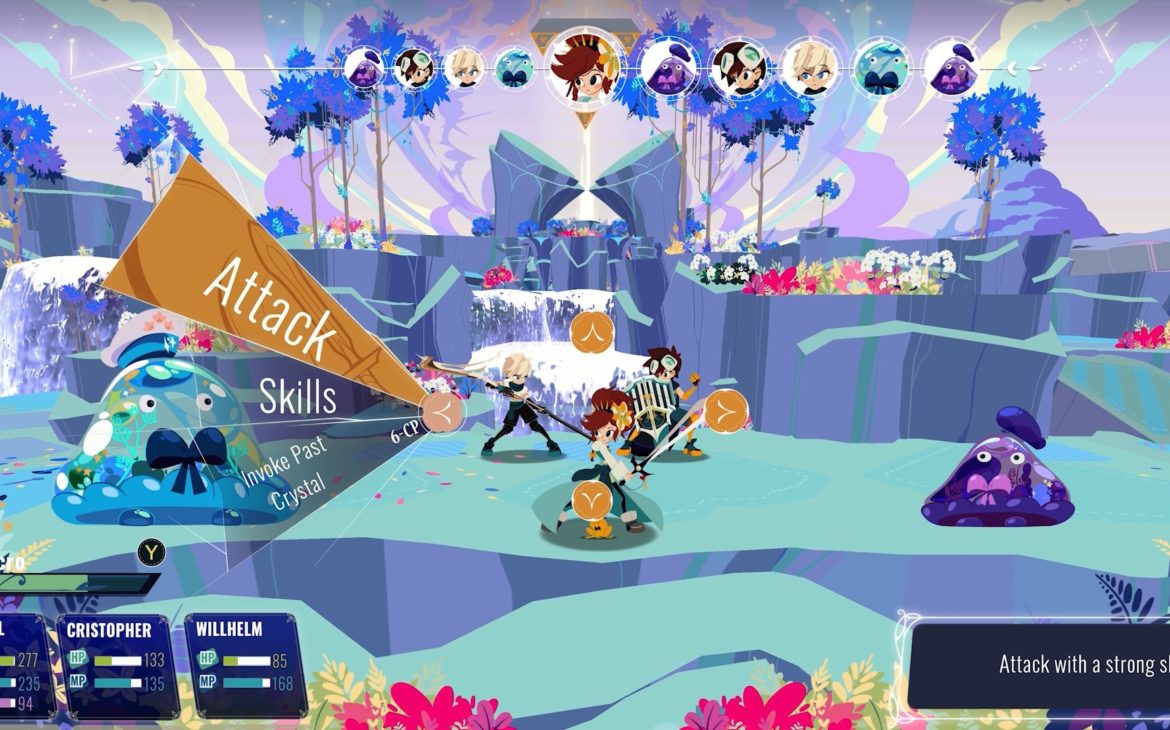
Think of it like evolving and devolving Pokemon mid-battle. Each enemy has a past, present and future self, and if the present one, err presents itself, you can shunt it forward in time maybe to when its old and decrepit, or back in time to before it developed its most damaging attacks. Gotta be careful increasing time on the right of the screen – in some cases you can make the enemies tougher too, bring them to their most powerful mature state.
It’s a really interesting system. One early use which piqued my interest a lot was throwing water magic at an enemy shield, then aging them in time, so that the shield rusts and is open to much more damage. This type of ingenious battle tactic is really clever and got me far too hyped. You see the trouble is that this really clever type of usage is pretty few and far between. As you advance in the story, the time powers become less and less useful or necessary. You end up powerful enough to take out most enemies quicker just by attacking or using elemental magic, than by spending turns and CP points to throw them back or forward in time. The balance is all off for it to be useful.
For example an enemy’s HP may reduce as you shunt that enemy into its infant state. That would be great if the adult state’s health were incredible, or unmanageable. Instead however, most of the enemy states don’t differ that much in health. Usually the only times I needed it were when a particular state enemy became completely invulnerable to physical attacks, and strategically it was the only course of action. In most bosses I felt the same, that the time advancing mechanic only made the smallest differences to battle.
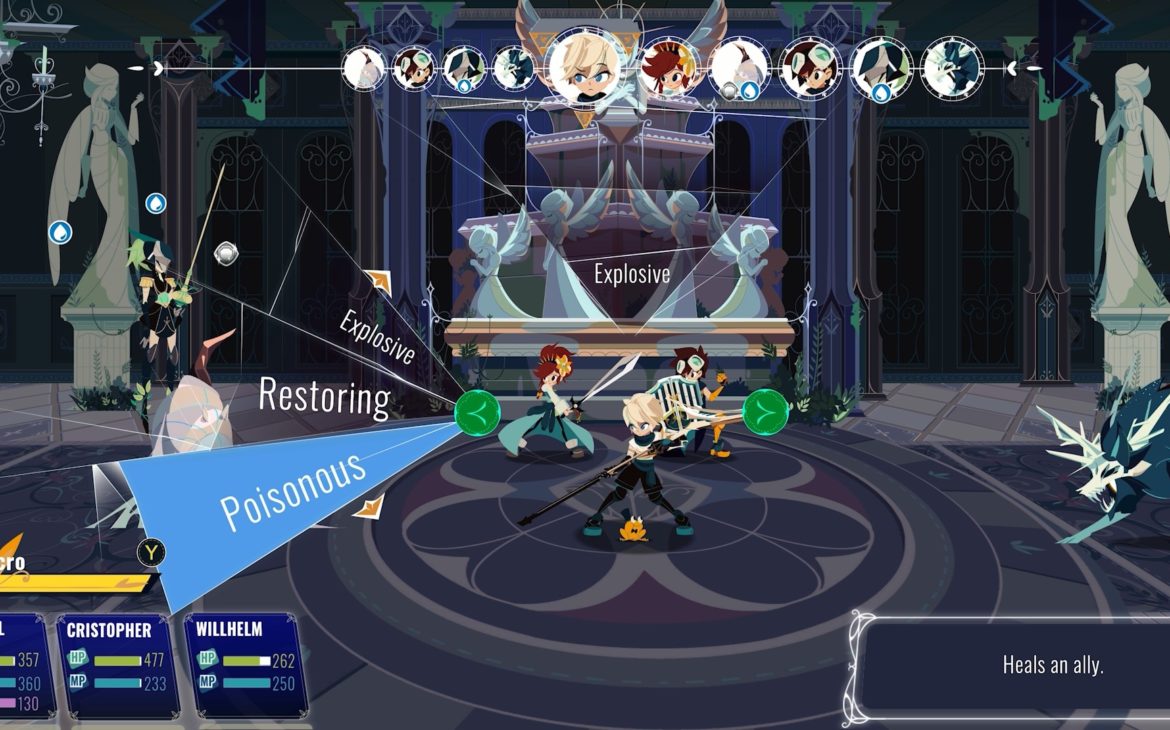
Besides the time mechanic, there are plenty of nice additions to battle. There is a fun gunblade-like click option as your attack connects, netting you double damage if done right. And the opposite for enemy attacks, allowing you to parry almost all damage. This mechanic makes battles constantly engaging, demanding you react to each hit and attack.
Syncros are partner-based limit break-like attacks. Actually you know what, they are lifted straight from the dual- and triple-techs from Chrono Trigger. Each does much more damage than each character could probably do combined, and if you’re clever with your elemental weaknesses, they’ll do even more. Plus you can hit that Gunblade sweet moment, and double the damage.
Wilhelm also has a number of support moves that utilise a little creature called a Yucandra to explode, poison, or scan the enemy. It comes in single hit variety, or AOE which requires you to push time forward to trigger. I did have issues with the Yucandra though. The Scan function only scans one of the three potentials for each enemy which is frustrating. Why not just show all three stages at once? They are usually weak to the same things, it’s mostly just a health difference – which would help you plan battles. Instead you have to methodically scan every enemy type at least 3 times to know what is your best strategy.
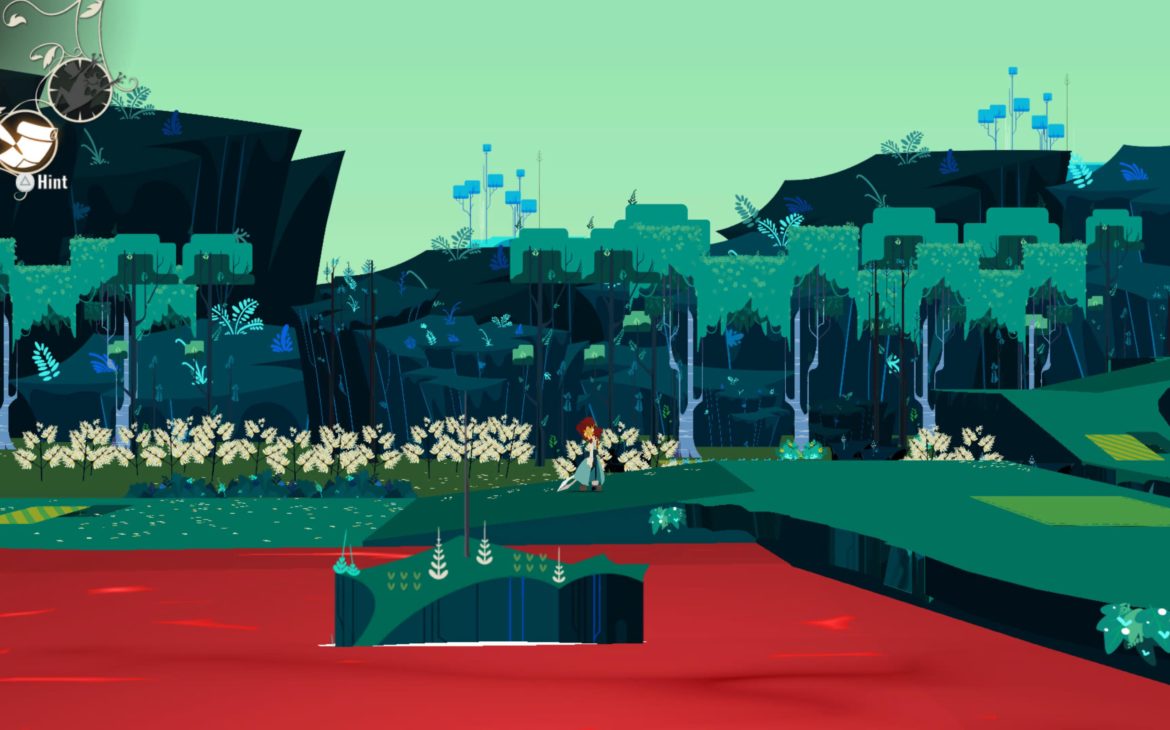
The Animations, FMV, locations and general character artwork throughout Cris Tales are stunning. They are unique, somewhere between anime and stop motion, often without much in the way of outlines, just allowing for the bold colours to show shape and design. There’s a certain Hunger Games elite opulence about almost every character design – every Mother Superior and every female character looks like they’ve been dragged through a Panem beauty pagent kicking and screaming. There are also a lot of bird-like characters, which I found interesting, just the lower halves of them with very bird-like legs and of course opulent feathers. Cris Tales design and aesthetic stand apart from the competition and clearly identify it in a crowded market.
In some locations the music is a quiet and pretty understated affair, fading a little into the background. However other locations, cities in particular had lots of very grandiose melodies, trumpeting and almost national anthem style themes. That same sort of grandiosity characterised the music of the Star Ocean franchise, so if you remember any of that, you’ll know where this goes.
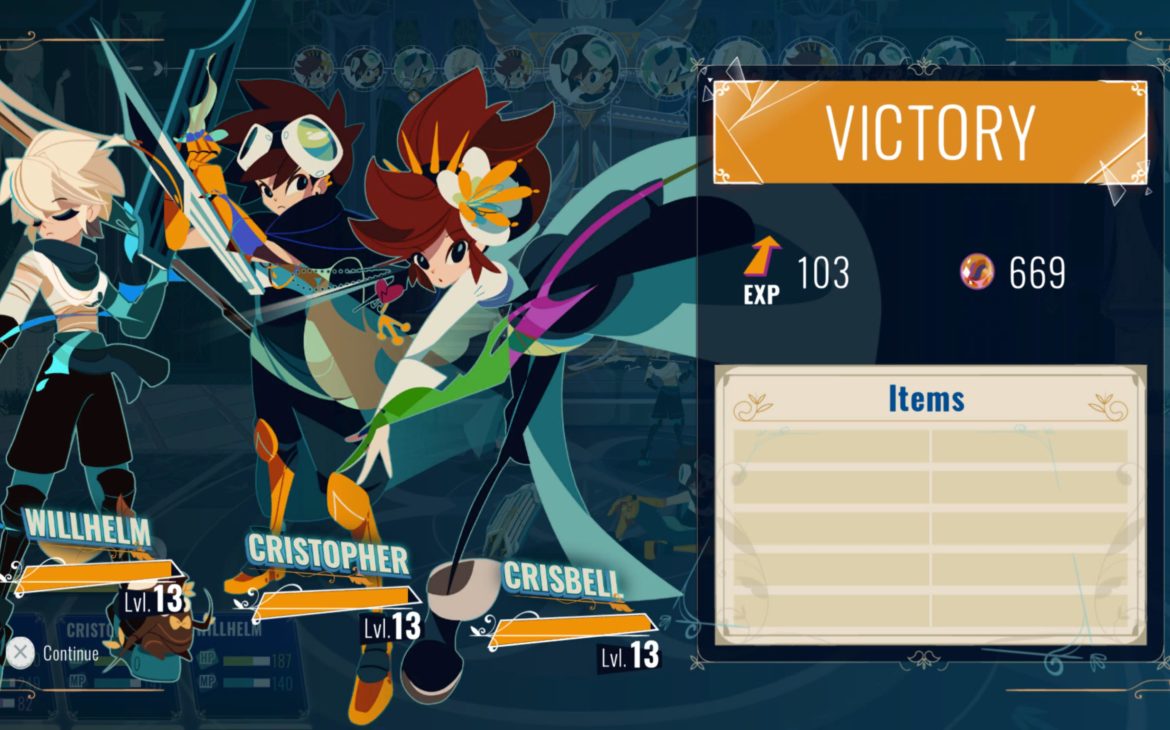
There are issues with balance across much of Cris Tales. While none of these make a large impact on their own, one atop another did sap my enjoyment, if only at times. Tents – that JRPG staple of Squaresoft that heal all MP and HP at a save point – they are so incredibly expensive in Cris Tales, that I never used one. The price was far higher than what a piece of canvas should cost, and encouraged me to suffer my way through every dungeon without ready access to MP. At the same time, MP totals are quite high, so for the most part that suffering wasn’t that bad, and I could happily use MP as often as I liked. The balance was off.
On that strange plain of 2D that Cris Tales’ locations exist in, Crisbell’s walk can be really annoying. She can only walk in certain areas as the explorable area is much smaller than the graphical depiction would have you believe, it means you are constantly walking into little invisible walls. Crisbell also moves really annoyingly slowly. During some dungeons, or back and forths across cities fulfilling quests, I just wanted a sprint, or a roll, anything to speed her up.
Said quests are also quite easy to miss. The game tries to clue you in to the fact that you are passing beyond a point of no return each time you’re about to complete a city, but this mechanic just felt unnecessary to me. Why lock the quests at all? I often didn’t leave that particular city straight away, and could have easily stayed in the area for a long time before being forced to move on. That said, the journey does push you along eventually, and rarely is there any way back to previous locales. There are points of no return but they don’t happen when the game warns you they will.
Lastly when the random battles trigger the battle screen to appear, the game often locks into 2-3 seconds of loading screen. What on earth needs to load on this game, that causes a 3 second loading screen on a PS5? It surely cannot be taxing modern hardware. It’s just not been optimised well.
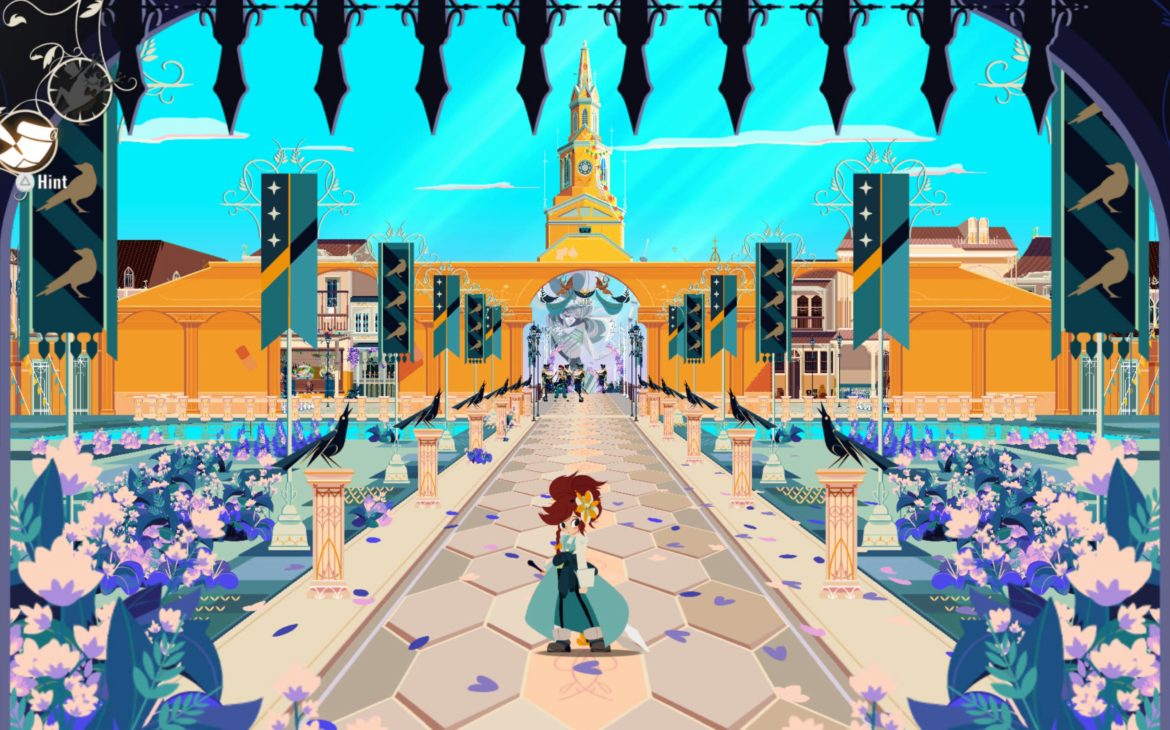
Undeniably beautiful, for a long time Cris Tales had me sold on its visuals alone. Add in a likable heroine, a team of five other fun characters, and a time mechanic that at first glance seemed revolutionary, and I was all in. However upon playing the game, that same level of hype has dimmed. The visuals are stunning, like a living cartoon, but soon the characters were less interesting than they seemed at first, the story revealed itself to be far shorter and more concise in scope than the epic the marketing had led me to expect.
The time mechanics slowly faded into the background, and combat became rote and unengaging. Most battles could be completed without any need for time manipulation, and without any design that brought it dramatically to the fore. It’s magic proved to be somewhat skin deep. Though I would not want to suggest this is will diminish anyone else’s time with the game, for me it was a case of maybe wishing the game was more than it was. You could say, with time comes perspective.
Cris Tales is a stunningly gorgeous indie, with art that’ll make your jaw drop. However many of its time mechanics are relatively skin deep, and it lacks the kind of depth its art inspires. It’s also not the epic it claims to be. It’s a love letter to classic RPGs, if within that same analogy those classics are the full novel.

Cris Tales is available now on PlayStation 4, PlayStation 5 (review platform), Xbox One, Xbox Series S/X (and Game Pass), Nintendo Switch, and PC via Steam.
Developer: Dreams Uncorporated, SYCK Games
Publisher: Modus Games
Disclaimer: In order to complete this review, we were provided with a promotional copy of the game. For our full review policy, please go here.
If you enjoyed this article or any more of our content, please consider our Patreon.
Make sure to follow Finger Guns on our social channels –Twitter, Facebook, Twitch, Spotify or Apple Podcasts – to keep up to date on our news, reviews and features.
